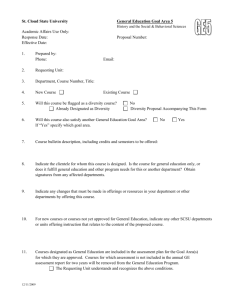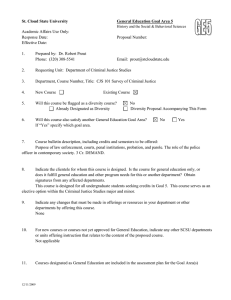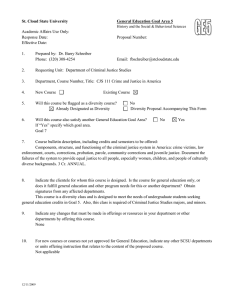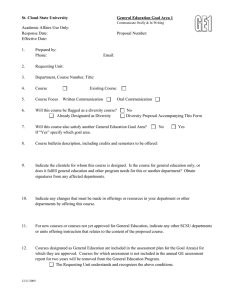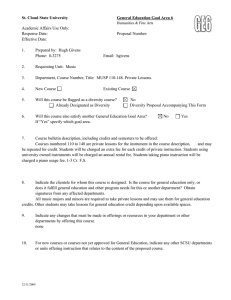St. Cloud State University General Education Goal Area 5
advertisement
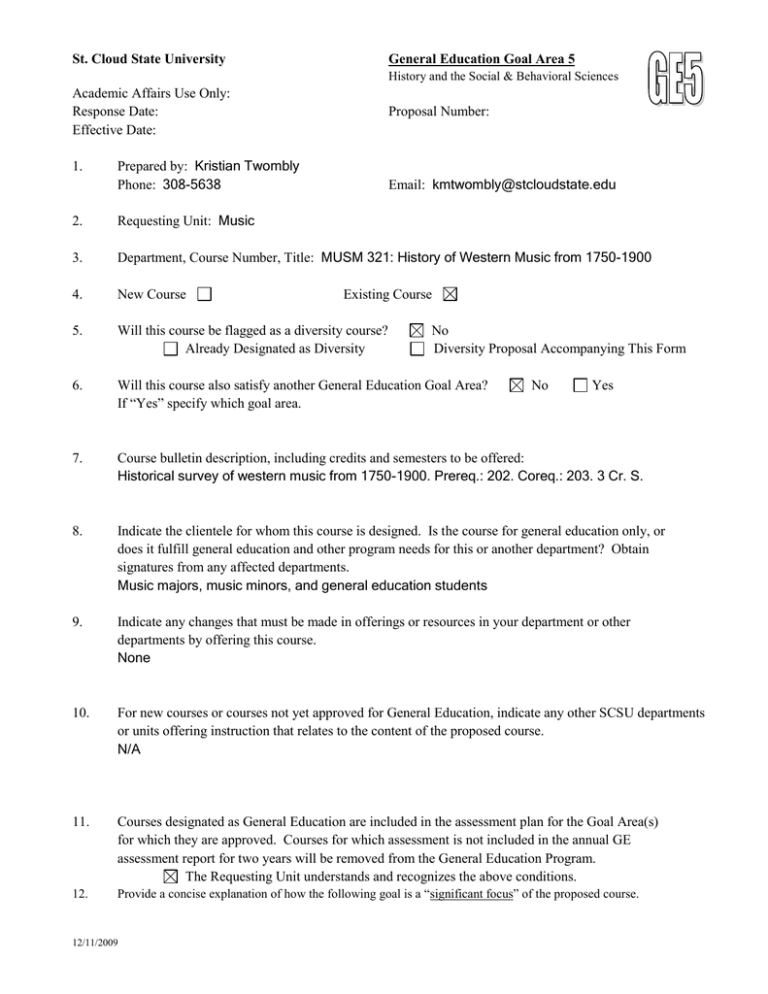
St. Cloud State University General Education Goal Area 5 History and the Social & Behavioral Sciences Academic Affairs Use Only: Response Date: Effective Date: 1. Proposal Number: Prepared by: Kristian Twombly Phone: 308-5638 Email: kmtwombly@stcloudstate.edu 2. Requesting Unit: Music 3. Department, Course Number, Title: MUSM 321: History of Western Music from 1750-1900 4. New Course 5. Will this course be flagged as a diversity course? Already Designated as Diversity 6. Will this course also satisfy another General Education Goal Area? If “Yes” specify which goal area. 7. Course bulletin description, including credits and semesters to be offered: Historical survey of western music from 1750-1900. Prereq.: 202. Coreq.: 203. 3 Cr. S. 8. Indicate the clientele for whom this course is designed. Is the course for general education only, or does it fulfill general education and other program needs for this or another department? Obtain signatures from any affected departments. Music majors, music minors, and general education students 9. Indicate any changes that must be made in offerings or resources in your department or other departments by offering this course. None 10. For new courses or courses not yet approved for General Education, indicate any other SCSU departments or units offering instruction that relates to the content of the proposed course. N/A 11. Courses designated as General Education are included in the assessment plan for the Goal Area(s) for which they are approved. Courses for which assessment is not included in the annual GE assessment report for two years will be removed from the General Education Program. The Requesting Unit understands and recognizes the above conditions. 12. Provide a concise explanation of how the following goal is a “significant focus” of the proposed course. 12/11/2009 Existing Course No Diversity Proposal Accompanying This Form No Yes Goal Area 5: History and the Social & Behavioral Sciences Develop understanding of human societies and behaviors, and of the concepts, theories, and methods of history and the social sciences. Students utilize a variety of methodologies and theoretical approaches to music written between 1750-1900. Through these critical frameworks, students gain an understanding and appreciation of the context in which these artworks were created and the role of music in different cultures in Europe during that time period. 13. In order for a course to be designated as fulfilling Goal Area 5, it must address at least 4 of the 5 student learning outcomes (SLOs) below. Check the SLOs below that are focused on in the proposed general education course. 1. Describe or use the methods and data by which historians, social scientists, or behavioral scientists investigate human conditions. 2. Analyze human behavior, cultures, and social institutions and processes from the perspectives of history or the social and behavioral sciences. 3. Develop explanations for and explore solutions to historical or contemporary social problems. 4. Reflect upon themselves in relation to family, communities, society, culture, and/or their histories. 5. Apply and critique alternative explanatory systems or theories about human societies and behaviors. 14. Discuss how each Student Learning Outcome checked above is achieved in this course. (Note: Although descriptions of typical assignments or types of assignments may be part of this discussion, it is not appropriate to submit copies of actual assignments.) 1. Through musical analysis, students actively utilize the same tools that historical theorists used to better understand the music of their time. In addition, students learn about the methodology that scholars use to better understand the creation and role of music from 1750-1900. 2. The history of music pre-1900 is essentially the music that was written down. Students learn from this written material, but also learn about music made that influenced this repertoire, some of which came from other cultures. Through careful analysis and criticial theory, students gain a deeper understanding of the origin and role of music made during the Classical and Romantic Eras. This includes the cultural context for individual works and stylistic trends. 3. As students learn about the cultural context for representative works and composers, they criticially examine the social and historical problems that gave rise to music of the era. Through this they gain a better understanding of the aesthetic solutions that composers and performers adopted at the time. For example, art and music had become too elite by the mid 19th Century, and composers such as Claude Debussy and artists like Claude Monet developed aesthetic systems that were meant to appear to a distinctly non-elite and untrained audience. 5. Students are exposed to a broad range of theoretical approaches to the material, ranging from detailed musical theory to social and behavioral theory, all in an effort to better understand the creation and role of music made from 1750-1900. 12/11/2009 15. List or attach the Course Outline (adequately described and including percentage of time to be allocated to each topic). Curriculum Committees may request additional information. Topics larger than 20% need to be broken down further. Indicate in your course outline where the Student Learning Outcomes checked above are being met. -Musical Taste and Style in the Enlightenment (5%) (1,2) -Opera and Vocal Music in the Early Classic Period (10%) (1,2,3,5) -Instrumental Music: Sonata, Symphony, and Concerto at Midcentury (10%) (1,2,3,5) -Classic Music in the Late Eighteenth Century (10%) (1,2,3,5) -Revolution and Change (5%) (1,2) -The Romantic Generation: Song and Piano Music (10%) (1,2,3,5) -Romanticism in Classic Forms: Orchestral, Chamber, and Choral Music (10%) (1,2,3,5) -Romantic Opera and Musical Theater to Midcentury (10%) (1,2,3,5) -Opera and Musical Theater in the Later Nineteenth Century (10%) (1,2,3,5) -Late Romanticism in Germany and Austria (10%) (1,2,3,5) -Diverging Traditions in the Later Nineteenth Century (10%) (1,2,3,5) 12/11/2009 St. Cloud State University General Education Transmittal Form Academic Affairs Use Only: Response Date: Effective Date: Proposal Number MUSIC Department: Course or Course(s): MUSM 321 History of Western Music 1750 from 1900 Department or Unit Chair Signature Date Department forward to Academic Affairs for publication and electronically to Chair of General Education Committee, Chair of College Curriculum Committee, College Dean Recommendation of General Education Committee: Approve Remarks: Disapprove Chairperson Committee Signature Date Recommendation of University Curriculum Committee: Approve Remarks: Disapprove Chairperson Committee Signature Date Recommendation of Faculty Association: Approve Remarks: Disapprove FA Senate Signature Date Action of Academic Vice President: Approve Disapprove Signature Entered in Curriculum Data File 12/11/2009 Remarks: Date
